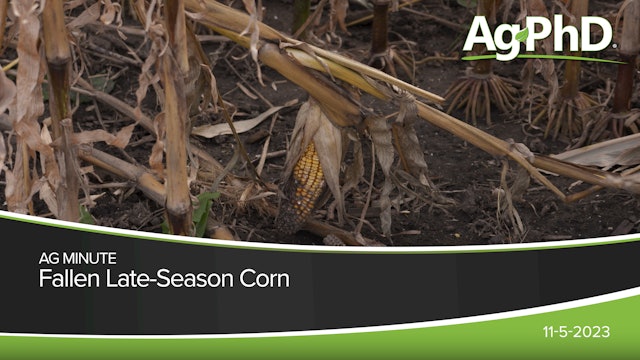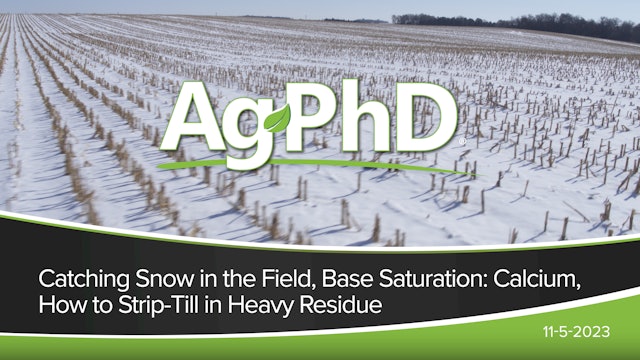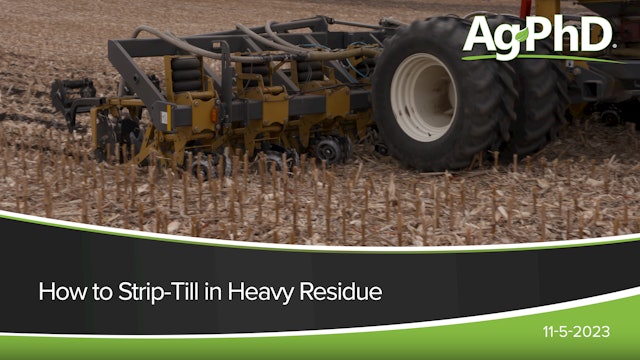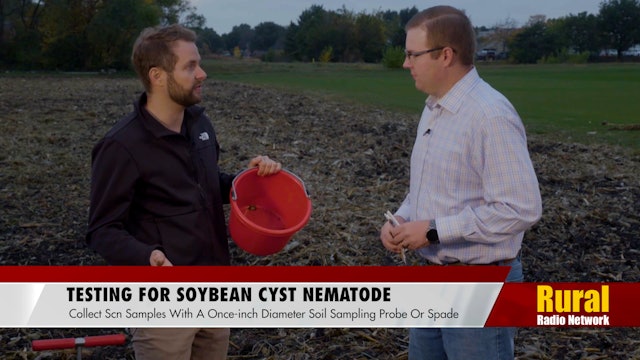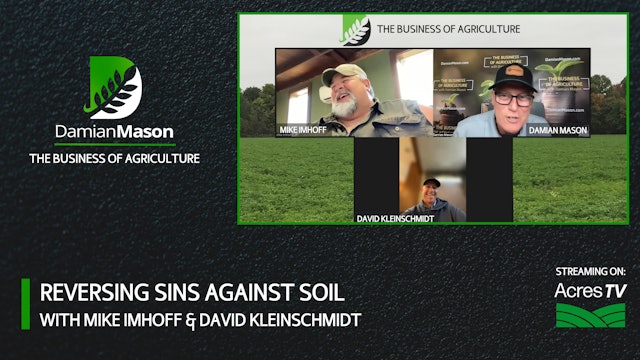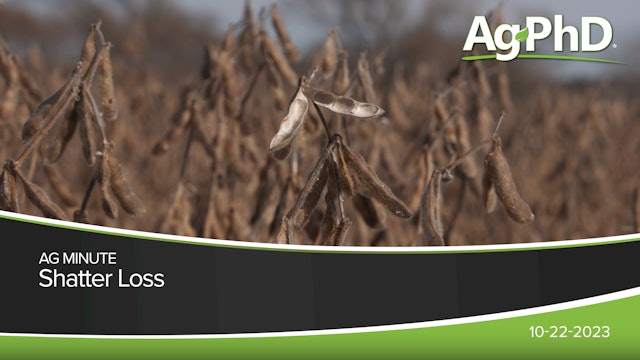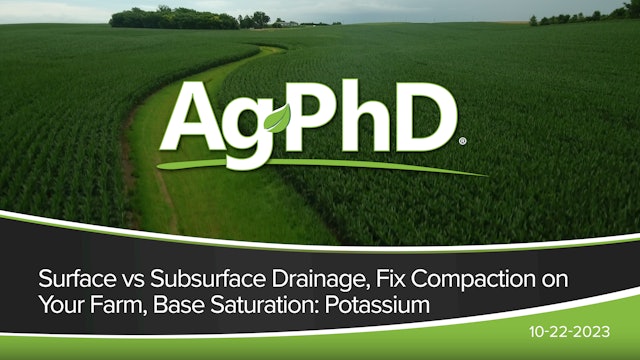Agronomy
How do you achieve better plant health and higher yields? Agronomy is the science of soil management and crop production, and these videos feature a wide array of topics that help protect and improve crops all throughout the season. If you want to build better crops, this is the place to start.
-
Fallen Late-Season Corn | Ag PhD
Darren Hefty talks tipsy harvest corn in today's Ag Minute.
-
Catching Snow, Base Saturation: Calcium, Strip-Till in Heavy Residue | Ag PhD
In this episode, Brian and Darren Hefty talk about: how to make all that winter precipitation work for you in the spring, how much Ca you need in your soil, and how to strip-till in a field thick with stalks and leaves. The Weed is roughstalk bluegrass, and protecting your bulk chemicals is the I...
-
How to Strip-Till in Heavy Residue | Ag PhD
Is a field ever too full of stalks and leaves to properly strip-till? The Hefty brothers say no. They share their advice from 20 years of planting in the black line.
-
Base Saturation: Calcium | Ag PhD
If your base/sat Ca is not between 60-80% your soil structure is suffering say Brian and Darren. This secondary nutrient needs to be in balance with the other elements found in your field.
-
Roughstalk Bluegrass | Ag PhD
It can be difficult to keep grass weeds out of your wheat. The Heftys tell you exactly what to use to control this perennial with stolons out of your fields.
-
How to Sample for Soybean Cyst Nematode in the Fall | Rural Radio
The end of the field season is near and many producers are likely to spend some time watching the yield monitor as they harvest. This time is a great opportunity to identify spots in the field with unexplained yield loss.
A potential explanation for these areas could be soybean cyst nematode.
...
-
Reversing Sins Against Soil | Damian Mason
As it turns out, we’ve not always been good to our soil. Fortunately we’re starting to better understand the living organism beneath our feet. However, we’re still mistreating this valuable asset that’s selling for $15,000 to $20,000 per acre in some areas. David Kleinschmidt of Progressive Agron...
-
Shatter Loss | Ag PhD
Why are soybeans harvested so quickly? In this Ag Minute, Darren Hefty explains why a timely harvest prevents shatter loss due to weather, drying, and disease.
-
Fix Compaction on Your Farm | Ag PhD
Brian and Darren help you to identify and repair the compacted parts of your fields, and tell you how to prevent this pressing problem in the future.
-
Base Saturation: Potassium | Ag PhD
It's all about balance in your soil and that's never more true then when looking at K. Potassium is maybe your crop's most important nutrient say the Heftys - you need to have the exact right amount.
-
Surface vs Subsurface Drainage, Fix Compaction, Base Sat: Potassium | Ag PhD
The Hefty brothers talk about how water's always flowing on or below your soil, how to handle compacted soil, and how to determine the right amount of K to have in your soil. The Weed of the Week is the evasive Russian knapweed, and Darren talks Demco grain carts.
-
Tissue Sampling | AgroLiquid B2B
Tissue sampling can be a powerful diagnostic tool. Pulling samples on a regular basis can help you stay ahead of potential issues that have yet to visually reveal themselves. It may also allow the opportunity to take corrective action in a timely manner. But, this tool must be handled properly.
...
-
Deficiency or Something Else | AgroLiquid B2B
Your crops are at the mercy of Mother Nature. As the season progresses, environmental conditions can stress your plants in various ways. Determining the proper response to these stresses in-season can be a challenge.
In this Back 2 Basics video, Brad and Ryan discuss weather and environmental is...
-
Fertilizer-Placement | AgroLiquid B2B
Two of the most important considerations when it comes to applying fertilizer are placement and timing.
For crops to reach their full potential, plant nutrition needs to have efficiency and maximum availability, regardless of how or when it is applied.
This Back 2 Basics video takes a closer l...
-
Micronutrient Deficiencies B, Cu and Mo | AgroLiquid B2B
When plants come up short in micros like B, Cu or Mo, it can have negative effects in numerous processes within the plant - as well as an impact on harvest. But what are those processes? What does it looks like? And, most important, what can we do about it?
In this Back 2 Basics video, Brad and ...
-
Micronutrient Deficiencies Zn, Mn, and Fe | AgroLiquid B2B
Micronutrients may not be needed in large quantities to achieve optimal plant health, however, they cannot be overlooked if you are looking to maximize yields. Deficiencies of micronutrients like zinc, manganese and iron can significantly effect plant development throughout the season - and yield...
-
Secondary Nutrients | AgroLiquid B2B
While primary nutrients such as nitrogen, phosphorus and potassium are widely recognized as essential for plant growth, the secondary nutrients, calcium, magnesium and sulfur, are equally important. Unfortunately, secondary nutrient deficiencies can be difficult to identify and manage. But, we're...
-
Potassium Deficiencies | AgroLiquid B2B
Potassium is a critical nutrient for plant growth, playing a key role in photosynthesis, water uptake and overall plant health. Insufficient levels of this nutrient can have serious consequences for the health of your crop.
In this Back 2 Basics video, Brad and Ryan discuss potassium management ...
-
Phosphorus Deficiencies | AgroLiquid B2B
Phosphorus is a vital nutrient for plant growth and development and is a key component of DNA and cell membranes. Every farmer should follow best practices with this primary nutrient to prevent deficiencies throughout the season.
In this Back 2 Basics video, Brad and Ryan discuss phosphorus bes...
-
Nitrogen Deficiencies | AgroLiquid B2B
Nitrogen is one of the most important nutrients for plant growth and is essential for crop yield and quality. Making sure your crops never run short makes all the difference come harvest.
In this Back 2 Basics video, Brad and Ryan discuss nitrogen management and deficiency watch-outs. Join the c...
-
Fertilizer Math | AgroLiquid B2B
Look at any bag, jug, or fertilizer label, and you will see three numbers separated by hyphens; these numbers represent nitrogen, phosphorus, and potassium content. This seems pretty straightforward, but how do you calculate how many actual pounds of nutrient is applied, and how does that calcula...
-
Fall Nitrogen Management | Ag PhD
The Hefty brothers discuss your best options for applying nitrogen in the fall.
-
Harvest Loss | Ag PhD
Brian and Darren Hefty explain harvest loss and how to calculate how much income could be lost per acre.
-
Nebraska Farmer Expects Above-Average Harvest Yields | Fridays in the Field
Timely rains and missed storms are leading Nebraska Panhandle farmer Glenn Miller to be optimistic about this year's harvest yields.
His wheat crop performed above average and he anticipates the same will be true for corn. Miller said it will still be two to three weeks before they'll be harves...



